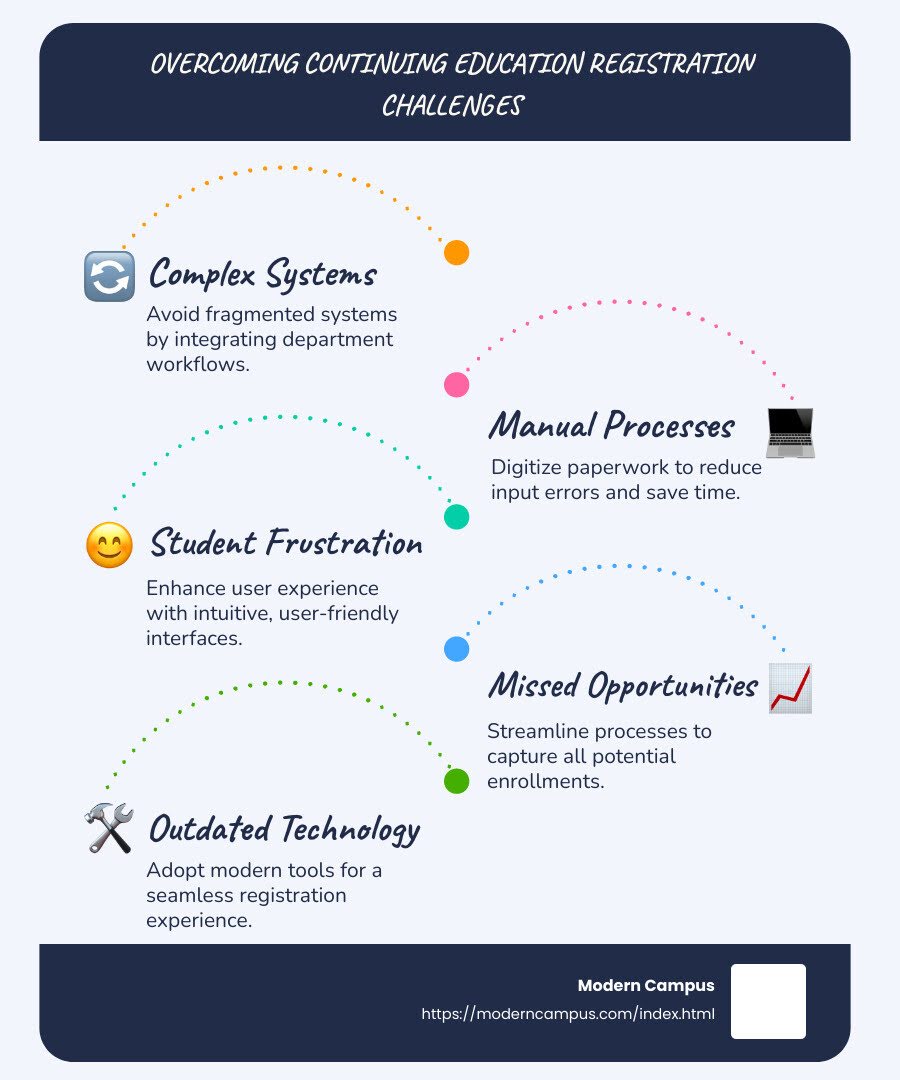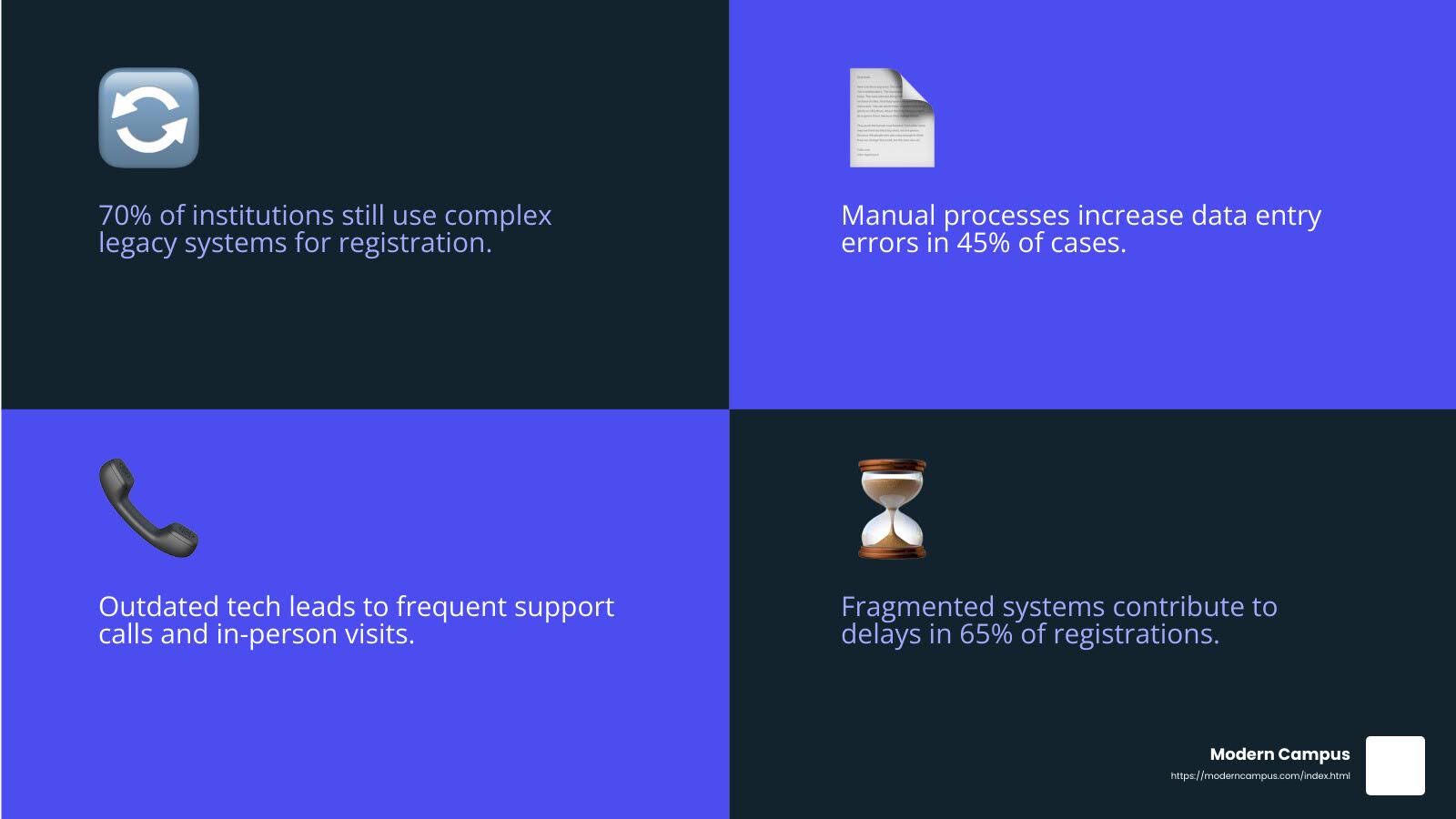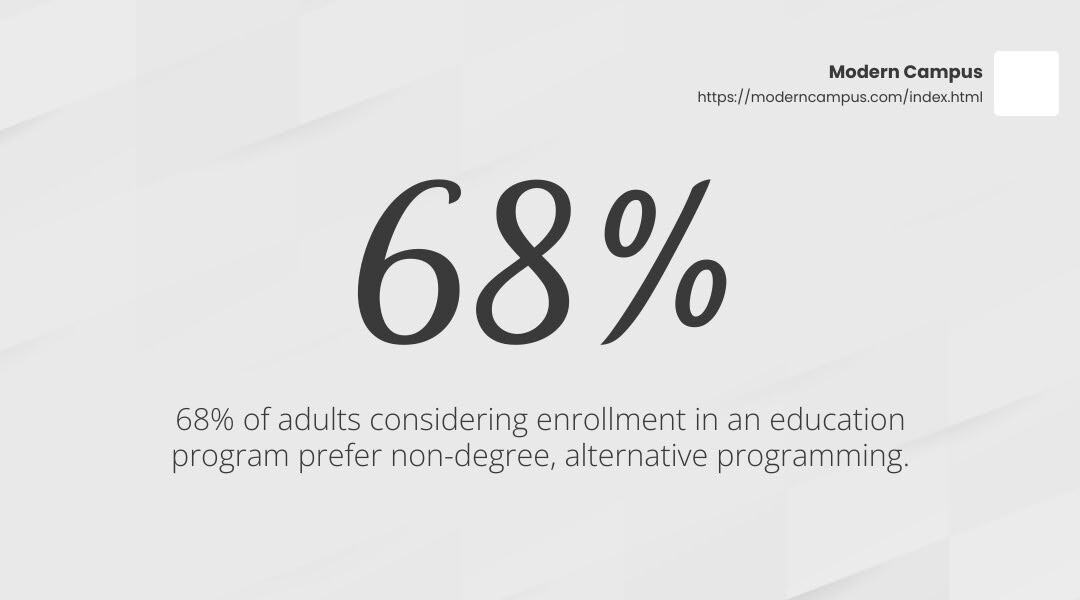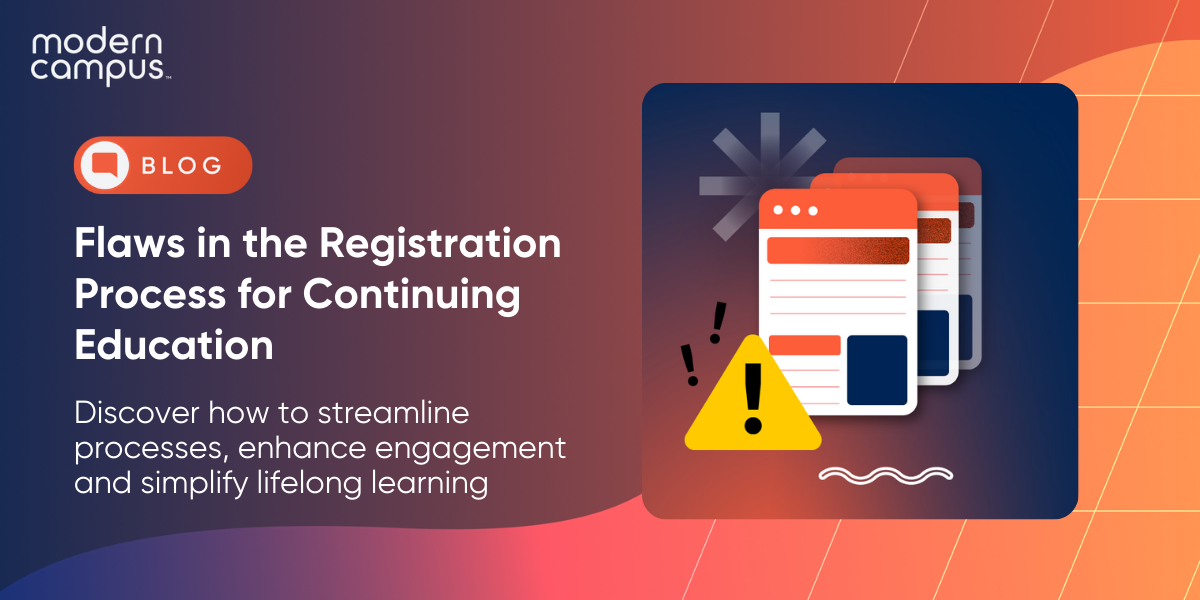Flaws in the Registration Process for Continuing Education
Continuing education is a vital part of one's career and life journey. With professional growth and new skills in demand, higher ed institutions must provide seamless registration processes to keep students engaged and satisfied. Evolving from traditional methods to digital, user-friendly systems is no longer optional—it's a necessity to improve efficiency and ensure the student experience is nothing less than smooth.
Continuing education registration software plays a crucial role in shaping lifelong learning experiences. For many higher education institutions, registration remains a significant challenge due to:
- Complex, fragmented systems that don't communicate effectively across departments
- High volumes of manual paperwork leading to errors and staff burnout
- Poor user experience that discourages student engagement and impacts satisfaction
These challenges not only affect daily operations but can significantly impact enrollment numbers. The following sections explore these issues in detail and discuss how modern registration software can address these fundamental problems.

Common Flaws in Continuing Education Registration
Continuing education registration often encounters several key issues that can hinder both institutions and learners.
Complicated Systems
Many institutions still rely on complicated systems that are not user-friendly. These systems often involve multiple steps and require students to navigate through cumbersome interfaces. This complexity can discourage potential registrants and lead to decreased enrollment numbers.
Moreover, fragmented systems that don’t communicate well across departments add to the chaos. This lack of integration can result in data silos, making it difficult for staff to access and manage student information efficiently.
Manual Processes
Manual processes are another significant bottleneck in the registration process. High volumes of paperwork lead to input errors and delays. Staff members often find themselves overwhelmed with repetitive tasks, which not only slows down operations but also leads to burnout.
Institutions that still depend on manual methods for data entry and record-keeping are at a disadvantage. These outdated practices are time-consuming and prone to errors, impacting the overall efficiency of the registration process.
Outdated Technology
The use of outdated technology is a persistent issue in many educational settings. Legacy systems may be unable to support modern features like mobile registration or automated payment plans. This lack of functionality can frustrate students who expect seamless, digital interactions.
Sticking to old systems can lead to missed opportunities. For instance, institutions may struggle to implement marketing tools or personalized recommendations—which are essential for attracting and retaining students.

To remain competitive and meet the expectations of modern learners, higher ed institutions must address these flaws by adopting continuing education registration software that is efficient, integrated and user-friendly. Embracing technological advancements is crucial for enhancing the overall registration experience and ensuring student satisfaction.
The Importance of Streamlined Registration Systems
Streamlined registration systems play a pivotal role in enhancing student engagement and operational efficiency. Let's explore why these systems are essential for both students and institutions.
Student Engagement
A seamless registration process can significantly boost student engagement. When students encounter a smooth and straightforward registration experience, they are more likely to feel positive about the institution. This positive experience starts from the very first interaction—registering for a course. Continuing education registration software offers mobile-friendly interfaces that allow students to enroll in courses anytime, anywhere. This flexibility is crucial for non-traditional students, such as busy adults who juggle multiple responsibilities.
Moreover, automated marketing tools (like personalized recommendations) help keep students informed and engaged. They receive timely reminders about upcoming courses or deadlines, reducing the likelihood of missed opportunities.
Efficiency
Efficiency is at the heart of a streamlined registration system. By automating routine tasks, institutions can save valuable time and resources. For example, payment plans reduce the administrative burden on staff by being managed automatically. This automation ensures that payments are collected on time without the need for constant follow-up.
Additionally, streamlined systems facilitate real-time data access and reporting. Staff can easily export registration histories or financial reports with just a few clicks, enabling them to make informed decisions quickly. This efficiency improves the institution's operational flow and the overall student experience.
User-Friendly Interfaces
User-friendly interfaces are a hallmark of effective registration systems. Intuitive designs make it easy for students to navigate the registration process without confusion. Whether they're using a computer, tablet or smartphone, students should have a consistent and hassle-free experience.
These interfaces also extend to personalized student portals where students can manage their personal information, view registered courses and update payment details. The ease of access and control over their own information empowers students and fosters a sense of ownership over their educational journey.
Adopting a streamlined registration system is not just about keeping up with technological advancements—it's about creating a better, more engaging experience for students. By focusing on student engagement, efficiency and user-friendly interfaces, institutions can ensure they meet the needs of modern learners while optimizing their own operations.

Key Features of Effective Continuing Education Registration Software
Continuing education registration software creates a seamless experience for both learners and administrators. Let's explore the key features that make these systems effective:
Mobile Registration
Mobile registration is a must-have feature. Learners need the flexibility to register for courses on the go, using their smartphones or tablets. A mobile-friendly interface ensures that they can easily sign up for classes anytime, anywhere. This convenience is particularly valuable for non-traditional students who are balancing work, family and education.
Payment Plans
Managing finances can be a major barrier to continuing education. That's why offering payment plans is essential. These plans allow students to pay for courses in installments, making education more accessible. Automated payment processing ensures that transactions are secure and hassle-free. This feature not only benefits students but also reduces the administrative workload for institutions.
Marketing Tools
Effective marketing tools are key to keeping students engaged and informed. Automated email campaigns can send personalized reminders about upcoming courses and registration deadlines. These tools can also recommend courses based on a student's past interests, helping them find new learning opportunities. By leveraging these marketing features, institutions can maintain strong communication with their students and encourage continued enrollment.
Personalized Student Portals
A personalized student portal is a one-stop shop for learners. Here, students can manage their course registrations, view their schedules and update their personal information. These portals empower students by giving them control over their educational journey. When students have easy access to their information, they are more likely to stay engaged and committed to their learning goals.
Seamless Integration
Seamless integration with other systems is vital for an efficient registration process. Whether it's syncing with learning management systems or financial software, integration ensures that all data flows smoothly between platforms. This connectivity reduces errors and saves time for both students and staff.
Effective continuing education registration software is built on features that prioritize convenience, accessibility and engagement. Institutions can improve the learner experience and streamline their operations by incorporating mobile registration, flexible payment plans, robust marketing tools, personalized portals and seamless integration.
Enhancing the Learner Experience
The learner's experience is paramount when it comes to continuing education. Let's explore how personalized portals, digital credentials and seamless integration can make all the difference.
Impacts of Personalized Portals on Students' Journeys
A personal dashboard shows everything you need in one place. With a personalized portal, learners can access their course schedules, track their progress and communicate with instructors—all from a single platform.
These portals are convenient and empower learners. When students feel in control of their education, they are more likely to stay engaged and motivated. Plus, institutions can tailor these portals to reflect their unique branding and messaging, enhancing the overall student experience.
The Value of Offering Digital Credentials
Traditional paper certificates are becoming obsolete. Instead, learners want digital credentials. These are verifiable, forgery-proof certificates that students can share online, showcasing their skills and achievements to potential employers.
Digital credentials are secure and highly customizable. Institutions can design them to include specific skills or competencies, making them more relevant to the job market. This approach benefits learners and helps institutions demonstrate the tangible value of their programs.
What Seamless Integration Looks Like in Higher Education
For a truly smooth registration experience, seamless integration ensures that the registration software works flawlessly with other systems like learning management systems (LMS), payment processors and customer relationship management (CRM) tools.
Integration ensures that data flows effortlessly between platforms, reducing manual data entry and minimizing errors. For learners, this means a more cohesive experience—where everything from course registration to payment processing happens without a hitch. For institutions it means saving time and resources, allowing staff to focus on more strategic tasks.
Incorporating these elements into your continuing education registration software can significantly improve the learner experience. By focusing on personalized portals, digital credentials and seamless integration, institutions can create an environment that supports lifelong learning and keeps students coming back for more.
Overcome the Flaws in the Registration Process by Adopting the Right Software Solutions
The main flaws in continuing education registration often stem from outdated systems that lack efficiency, flexibility and user-friendliness. These systems can result in confusing navigation, manual errors, slow processing times and poor communication with learners—all of which hinder enrollment and overall satisfaction. Additionally, the inability to offer personalized experiences or integrate with other institutional systems can create barriers for students seeking streamlined registration and access to learning opportunities.
The right software solution can address these issues by automating the registration process, offering intuitive navigation and providing real-time communication. By adopting advanced registration software, institutions can eliminate these challenges and ensure a seamless, efficient and engaging experience for learners.
Higher education institutions can provide students with the tools and experiences they need to succeed—from their first registration to their eventual career achievements.
By utilizing the right platform, institutions can streamline operations, improve student engagement and ultimately deliver a modern learner experience. This is more than just keeping up with technological advancements; it's about leading the way in educational innovation.
Modern Campus stands out as a leader in changing how institutions manage and deliver education. By embracing our learner-to-earner lifecycle approach, colleges and universities can ensure they are not just meeting the needs of today’s students but preparing them for the challenges of tomorrow.
Explore how Modern Campus can revolutionize your institution's continuing education registration process.
Last updated: January 7, 2025

